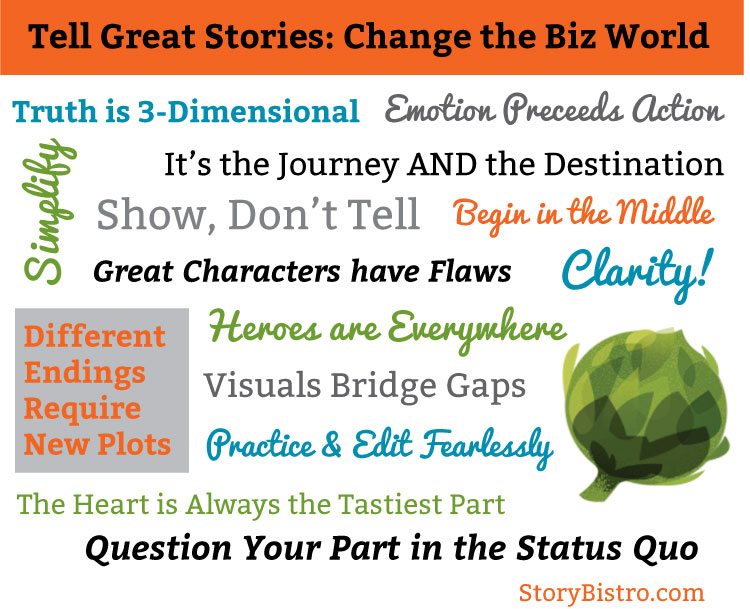This isn’t just another bandwagon. This is truly important stuff.
Especially if you’re a mission-driven entrepreneur who has some world-changing ideas, products, or services.
You know that business IS personal. That it SHOULD be personal. How else will we ever fix what’s broken with Corporate America?
You’ve also heard from a slew of storytelling experts, all advocating the use of stories in your content marketing.
Yes, yes. We get it.
But HOW do you — the micro biz owner who may not have the budget to hire a team — learn to tell an engaging story? Something that will move your clients to action?
There’ve been a ton of books written on the topic, though most are aimed at larger organizations.
And there’s certainly no shortage of information about there about WHY we need to tell more stories.
But if you’re stuck doing it all yourself, the learning curve might feel steep and scary. Even if you’re a writer by trade, it’s likely that you’ve never studied storytelling in any sort of detail.
The good news is that you can actually learn this stuff. It just takes patience, a keen desire to hone your skills and a good mentor or two. That’s why Story Bistro exists. To help you tell better stories so you can move people to action and build a stronger business.
So let’s talk about how to do that, shall we?
A Business Storytelling Manifesto
1. Your business is a story. It has characters (a hero, a villain, a mentor, side-kicks, and supporting players). It takes place in a particular setting (where you sell and deliver your goods). There’s often a main goal that the hero wants to solve, and there are various plot points along the way. When you conceptualize your business as a story (or a series of them), it helps you approach the marketing process in a more creative way. And creativity is definitely what we want to nurture if we want to create messages that catch our clients’ attention.
2. It’s not about you. The hero is your Ideal Client. You, dear storyteller, play the role of mentor. Always remember to showcase THEM. Even (and especially) on your About Page.
3. Your hero has a goal. And she’s foiled at every turn by a villain. It’s important to understand that dynamic exists so you can tell stories that show her you get what she’s going through.
4. A story is an invitation. And that means it requires at least two parties to fully exist: the storyteller, and the story-listener (the audience). The best stories include a call to adventure. They’re an open door that says please come in, I’d love to share this with you. And here’s why it’s important. We allow people into our lives (and our businesses) through stories. And they invite us into theirs the same way. It’s important therefore, to listen deeply and to remember, that the best storytellers listen first before they ever open their mouths. Listen. Call. Response.
5. It’s the journey AND the destination. Enjoy the steps along the way, but never forget that good stories have a point — a moral or a lesson. Know your ending before you know your middle. That way, when you edit, every step leading up to that point will be relevant and on track — this helps you stay focused and live up to the promise embedded in your title.
6. Size matters. (But not in the way you think.) Epic isn’t just about larger-than-life action adventure. You can tell a great story in 6 words, or 140 characters or five epic volumes. The story should be as long as it needs to be and no more. What matters most is that your audience gets there. (And in that same vein, don’t worry about the size of your audience. A quality audience is SO much better than one focused on quantity.)
7. Truth is three-dimensional. There are at least three sides to every story: yours, theirs and the “objective truth.” Know them all. The good, the bad, and the ugly. Include them all, if you can. That’s transparency. That’s authenticity. Storytelling in business needs more of that. And a lot less spin. If you exclude a truth, what you end up with is a fairy tale.
8. Different endings require new plots. We create change in our lives when we change our stories — about the past, present and future. If our customers need or want to change, we can serve them best by helping them shift the stories they tell themselves about what’s possible. In order to do that tho, we first have to connect to them where they are.
9. Question your part in the status quo. Examine your stories and find the places where you mimic others. Are you simply repeating what others say? Or do you speak from first-hand experience? Make conscious choices about how your stories unfold. And if you seek to change the status quo, find an angle that helps your audience feel your truth as their own.
10. Know (and tell) the Origin Stories. Your Big Why is just as important as your Ideal Client’s. Most of our buying decisions are based on the Why not the What.
Great stories agree with our world view. The best stories don’t teach people anything new. Instead, the best stories agree with what the audience already believes and makes the members of the audience feel smart and secure when reminded how right they were in the first place. —Seth Godin, Author, Tribes: We Need You to Lead Us
11. Begin in the middle. Great stories start where they’re most interesting. En media res is where you leap from — the midst of things, the action. Hook your readers first and then reveal the back story slowly, over time.
12. Great characters have flaws. We admire and relate better to those who experience failure than those who always win. Don’t be afraid to reveal who you are — and who you were — especially if your flaws and failures can inspire others. And always remember that your customers (the heroes!) are human, too.
13. Bridge gaps with visuals. A great picture is worth 10,000 words — mainly because it has the ability to connect different tribes or cultures. It’s a nearly universal medium. It also helps us connect faster to a story and remember it later. But you can also paint a picture with words. This is what we mean by “Show, Don’t Tell.”
Vision takes up 50% of our brain’s resources. In neurology, this is called the pictorial superiority effect. If I present information to you orally, you’ll probably only remember about 10% 72 hours after exposure, but if I add a picture, you’ll likely remember 65%.
14. Practice! Good storytelling is a learned skill that takes practice. If you want to get good at storytelling, you need to do a LOT of it. Over and over and over again. Be patient. And where possible, enlist the objective feedback of others.
15. Nurture your creativity so you can lead. One of the best ways to find and tell better stories is to stay curious and feed your imagination. What’s possible? Can you paint a picture of something that doesn’t yet exist? If you can, you’ll become a storyteller who leads.
16. Connect to the emotions. Remember you can get your audience to take action if you connect to their emotions. Both positive and negative.
17. Use your stories for good. Words have power. And with great power, comes great responsibility. You can either build someone up or tear them down. From time to time, you may need to both.
“Words, are our most inexhaustible source of magic. They are our most potent forms of enchantment. Rich with the power to hurt or heal.” – Dumbledore, Harry Potter and the Deathly Hallows
18. The Heart is the Best Part. Just like an artichoke, your story will have layers. And like an artichoke, the heart of your story is what matters most.
The Best Stories evolve over time and this manifesto will, too. Do you have anything to add? Change? Share your thoughts in a comment below!












Trackbacks/Pingbacks